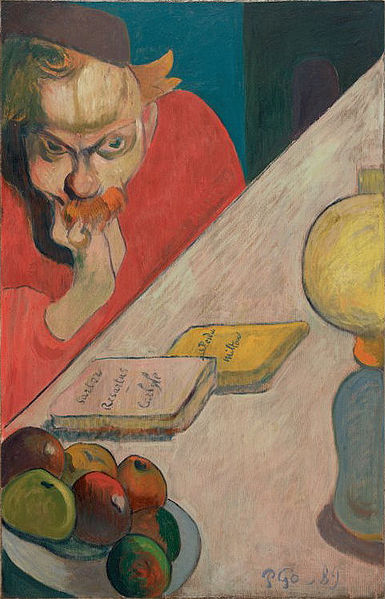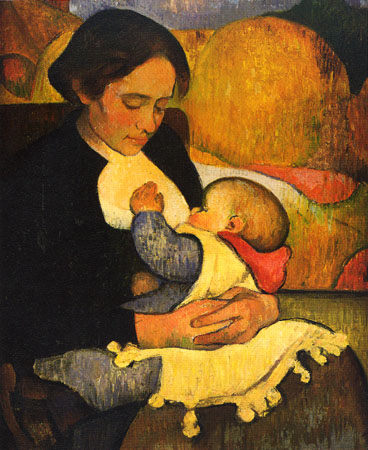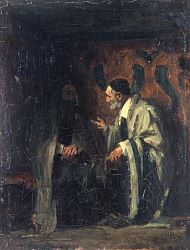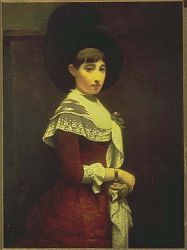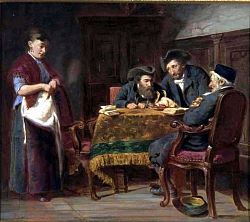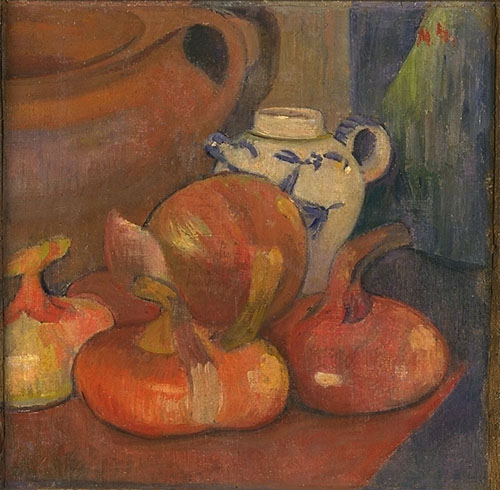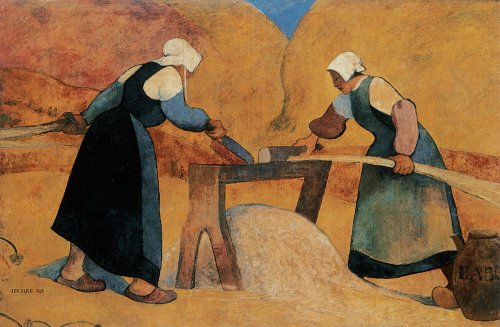<Back to Index>
- Painter Maxime Pierre Dethomas, 1867
- Painter Meijer de Haan, 1852
PAGE SPONSOR
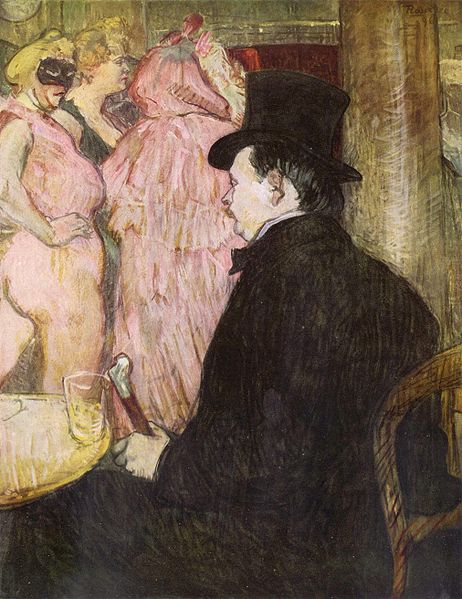
Maxime Pierre Dethomas (October 13, 1867 - January 21, 1929) was a painter, draughtsman, pastellist, lithographer, illustrator, and was "among the best known metteurs en scene and decorators" of theaters. As an artist, Dethomas was highly regarded by his contemporaries and exhibited widely, both within France and abroad. During the later part of his career, he is best remembered for his work overseeing set and costume design for the Théâtre National de l'Opéra and the Théâtre des Arts, Comédie - Française. The Musée d'Orsay (Paris), the Pushkin Museum (Moscow) and the Hermitage Museum (St. Petersburg) hold works by Dethomas, but the majority of his best work remain in the private collections of his descendants. A large collection of Dethomas's theatrically related work is held at the Bibliothèque - Musée de l'Opéra National de Paris. Dethomas is also remembered for his close friendship with the artists Henri Toulouse - Lautrec, his brother in law Ignacio Zuloaga and his association with Les Nabis and other important Symbolist and Post Impressionist artists and writers. Dethomas died in 1929 and was buried at the Passy Cemetery in Paris.
Born in Garges - lès - Gonesse, Val - d'Oise, Maxime Dethomas came from a long line of painter - printers on one side of his family and of lawyers on the other. His father, Jean - Albert Dethomas (1842 – 1891), was an important Parisian politician. His step mother Louise Thierree (Jean - Albert married twice – Maxime was of the first marriage) belonged to the affluent middle class of Bordeaux.
Dethomas enrolled at the École des Arts Décoratifs in 1887 at which he studied for a brief time, followed by a more varied course, from 1891 onwards, at the Societe de la Palette (boulevard de Clichy) directed by Henri Gervex, Puvis de Chavannes and Eugene Carriere. Carriere's influence played a significant part in the early development of Dethomas's art, and he would go on to be a close friend of both the artist and his family. Dethomas passed much of his time at the bookshop of the Revue Indépendante (Independent Review) run by Edouard Dujardin, and it was here that Dethomas first met Louis Anquetin and Henri Toulouse - Lautrec. Dethomas worked primarily as an artist from the early 1890s until his appointment in 1910 as the director of design at the Théâtre des Arts.
Dethomas's early style owes most to the influence of Carriere and Degas, whilst later works tend more towards that of Toulouse - Lautrec, Legrand and Forain. Dethomas himself claimed that his inspiration was guided by artists of earlier generations, particularly Goya, Delacroix and Manet, but his individuality of style ensured he would "not be influenced in his work by any methods or thoughts other than his own". He realized vigorous charcoal drawings showing views of Paris and Italy, as well as portraits of his friends Edmond Rostand, Catulle Mendès, Toulouse - Lautrec, Henri de Régnier (whose Esquisse Vénitiennes he illustrated), Forain, etc. Dethomas was a prolific lithographer, and through his close connections in literary circles, many of his lithographs were published in print. He illustrated works by Maurice Donnay, Octave Mirbeau and, in 1922, Molière's theater. In a letter of introduction for Dethomas, written by Lautrec in the summer of 1895 to Joseph Ricci, Lautrec refers to Dethomas as his dear friend and compliments him as a painter "who doesn’t talk about his paintings, something that is to be admired". Dethomas produced advertising posters as early as 1897, which, as with his contemporaries, contributed to his fame. Dethomas marketed his art via the Durand - Ruel Galleries and Galerie Druet and is known to have had his works framed by the frame - maker and art dealer Pierre Cluzel (1850 – 1894), and his successor L. Vivien, at Cluzel's workshop (33 Rue Fontaine, Montparnese). In 1912 Dethomas was awarded the Chevalier de la Légion d'honneur.
Dethomas worked under Jacques Rouché at the short lived Theatre des Arts (1910 – 1913). Upon his appointment as director, Rouche enlisted the talents of several artists of Les Nabis group who had contributed to the Grande Revue, including Jacques Dresa, René Piot and Maxime Dethomas, none of which had previously worked for the stage. As
chief set designer or director of the Services Plastiques, Dethomas
embarked on a career that would last for the remainder of his life. The
Theatre des Arts represented a major shift away from facile acting,
shallow content and the painted canvas drawing rooms of commercial
theater, that were the norm in early 20th century European theater. The
inaugural production, Carnaval des Enfents (1910), marked a major theatrical revolution by which Dethomas's settings
accentuated line and color, rather than painted detail and endless
props. Against blue, ochre, grey and steel, black costumed characters
created striking pictorial compositions in lighting effects that "varied
like inflections in a conversation." The Theatre des Arts went on to
present nearly twenty plays, including Jacques Copeau's adaptation of Brothers Karamazov (1911), and the production of La Tragedie de Salome (1912),
both a popular and critical success. Due to the small
size of the theater, it eventually ran into financial trouble and
closed. Hired to direct and design at the Paris Opera (1914 – 1936),
Rouche and Dethomas went on to offer fresh interpretation of old material and to make inroads into stale scenic convention.
By 1917 Dethomas was also designing sets for the Comédie Française. Dethomas's reputation was such, that in early 1912, he was
commissioned by the British Aristocracy to design a set for a London
masked ball with some 2000 guests. Guillaume
Apollinaire felt that Dethomas's influence on French Theater had
"transformed the art of scenery, costume design and staging. In 1926 the Opéra - Comique in Paris celebrated Manuel de Falla's
50th birthday with a program consisting of La Vida Breve, El Amor
Brujo, and Master Peter's Puppet Show, with new designs by Falla's close
friend Ignacio Zuloaga, and new marionettes carved by Dethomas. Dethomas
once wrote that above all else decor should be a good servant of the
play and that a designer must get beyond a painterly "feel" to something
more solid.
Lautrec nicknamed him "Grosnabre" for his dead - pan face; Thadee Natanson described him as a gentle giant, polished and discreet – "He was so frightened of wearing anything that might draw attention to himself that even the black of his clothes seemed duller than that worn by others." Paul Leclercq states that what fascinated Lautrec about Dethomas was "his ability to preserve an impassive appearance even in a place of amusement". Lautrec and Dethomas formed a close friendship during the early 1890s – so much so that Dethomas became Lautrec's "closest friend". Dethomas' placidity, corpulence and extreme shyness (he always blushed when he had to raise his voice) endeared him to Lautrec. Two known portraits of Dethomas (by Lautrec 1896 and Opissio) show Dethomas with his face averted, which says much of his shy manner. They often visited brothels and cafes in the Montparnese together; these visits played an intrinsic role in the development of Lautrec's Art. During the summer of 1895 Dethomas traveled to the Normandy coast with Lautrec. Lautrec moved to 30 Rue Fontaine from June 1895 onwards, near Dethomas, and stayed there until 1898. In 1896 Lautrec painted the famous portrait of Maxime Dethomas at the Bal de l'Opera and Debauche Avec Dethomas, a lithograph later used on the cover of an exhibition catalogue. In 1897 (20 June - 5 July) Dethomas sailed Holland's canals on a barge with Lautrec and visited Utrecht and the Frans Hals Museum at Haarlem. Their friendship lasted until the end of Lautrec's life.
Dethomas was a friend to Marcel Proust. Proust made a favorable mention of Dethomas's landscapes of Venice in Remembrance of Things Past and discussed the quality of his work at an exhibition at the Durand - Ruel Galleries. In a letter to Dethomas of March 1903, Proust wrote that after having seen his exhibition, he received "a profound initiation to the understanding of nature and love of life." He continued, "it seems that one has gotten from you new eyes to look at life and men and even down to those little windows on the Grand Canal that I would love to juxtapose with yours."
During the 1890s, Dethomas formed a close friendship with the artist Ignacio Zuloaga, who lived in Paris at this time. Zuloaga studied under Eugene Carriere with Dethomas, and by 1892 they were close friends - Dethomas invited Zuloaga to stay with his family for some period – during which Zuloaga formed a bond with Maxime's Half - Sister Marie - Valentine. Zuloaga went on to marry Marie - Valentine on May 18, 1899, with Eugene Carriere and Isaac Albéniz as witnesses.
The author Pierre Louys was also a close companion of Dethomas and had collaborated with him on the first edition of Le Centaure in
1896. During August and September 1898, Dethomas acted as a marriage
broker of sorts, attempting to bring together his sister Germaine and
Pierre Louys, a plot that was thwarted by Dethomas's stepmother.
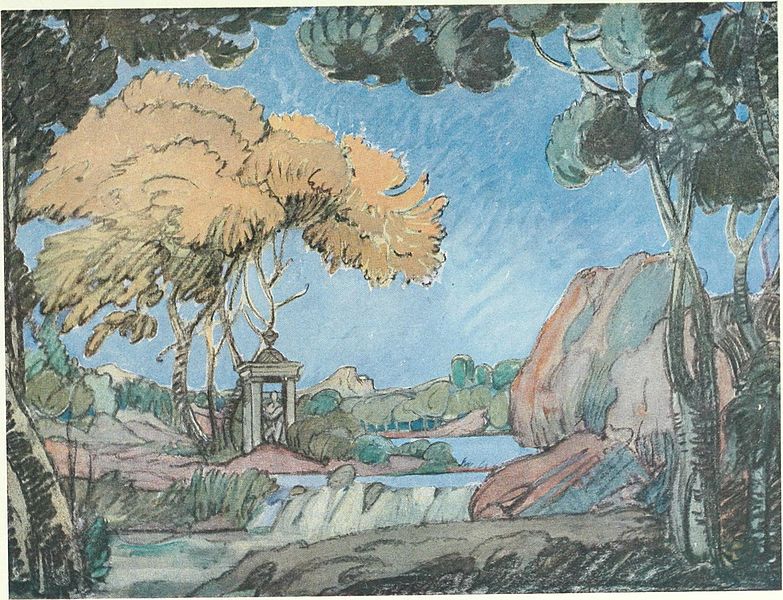
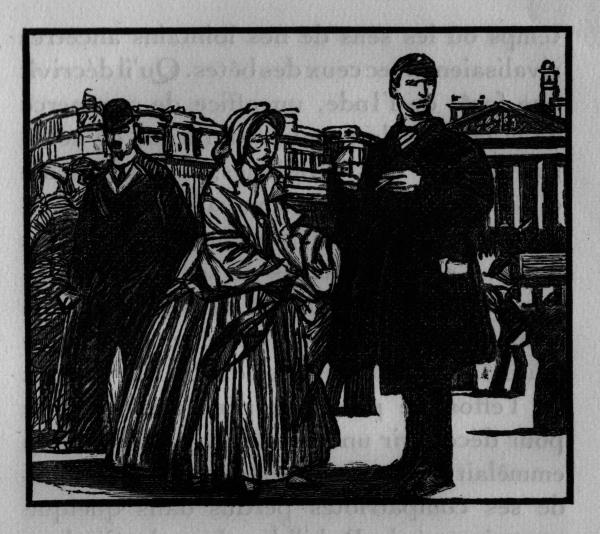
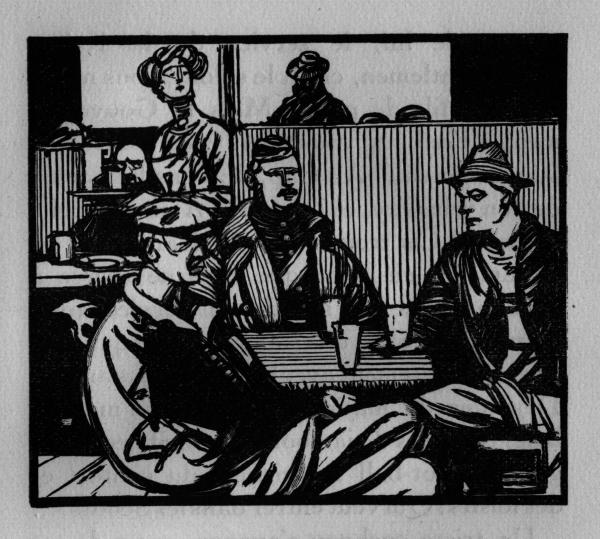
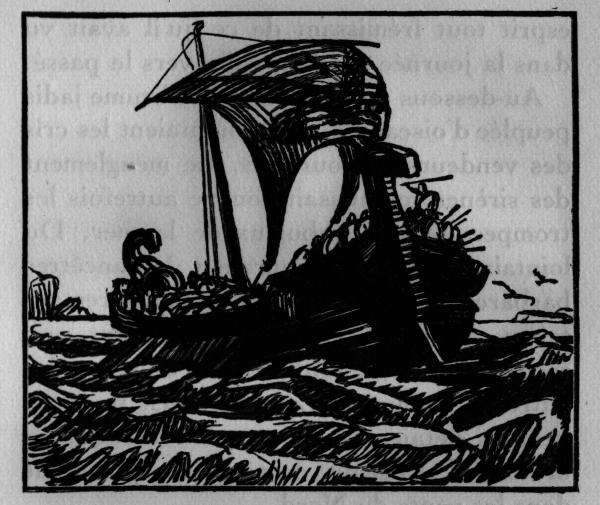
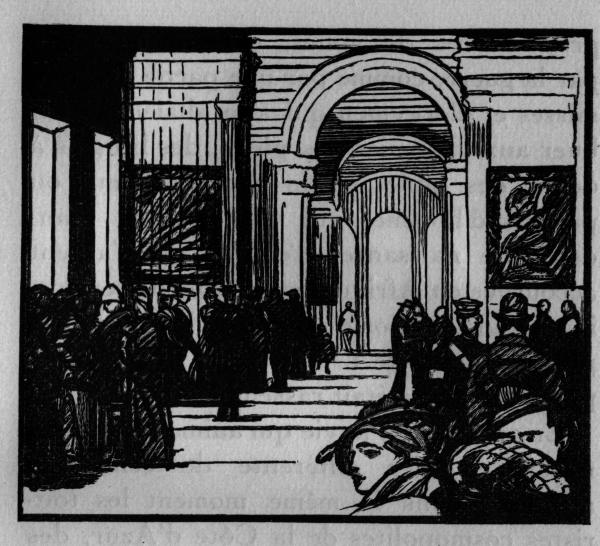
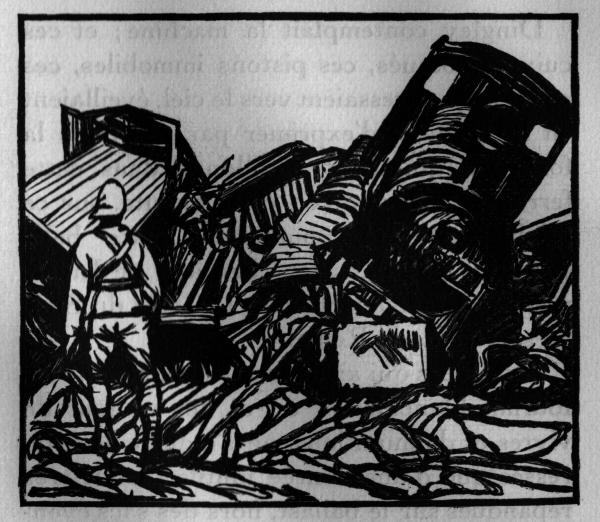
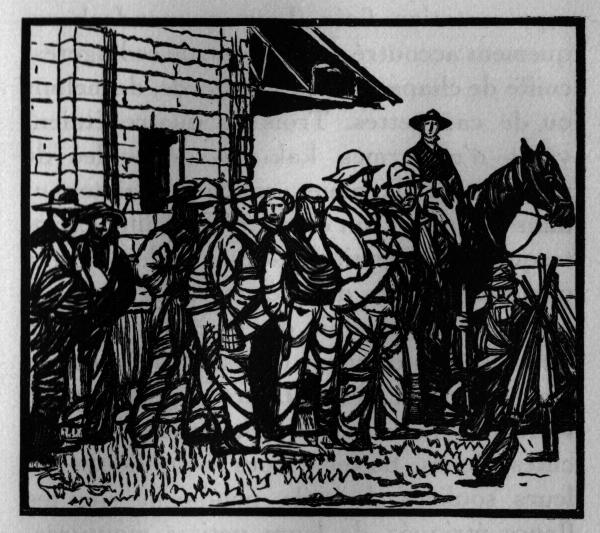
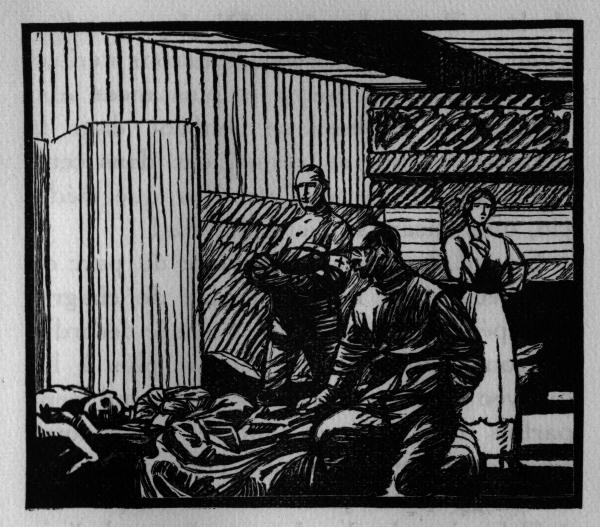

Meijer de Haan (April 14, 1852, Amsterdam - October 24, 1895, Amsterdam) was a Dutch painter.
He was born into a successful Jewish family of biscuit manufacturers, close to the study of religion, music and art. He had already had some success in the Netherlands as a painter of Jewish genre works. In Amsterdam de Haan painted portraits and took on several pupils, including Joseph Jacob Isaacson, Louis Hartz and Baruch Lopes de Leao Laguna.
In the winter of 1888, accompanied by his pupil Joseph Jacob Isaacson, he went to Paris to continue his studies. There he met Pissarro, Theo van Gogh, and Paul Gauguin, back from Arles, whom De Haan accompanied to Brittany - first to Pont - Aven, and later to Le Pouldu, on the coast of Brittany.
Van Gogh introduced De Haan to his brother Vincent van Gogh, and Meijer de Haan exchanged several letters with Vincent. In Brittany, De Haan had a liaison with Marie Henry, the owner of the seaside hotel - café Buvette du plage, where de Haan and Gauguin lodged in 1890 - 1891. They covered the walls of the dining area with impressionist murals, that were only papered over in the 1920s. Since discovery they have been restored and sold.
Marie Henry gave birth to a daughter who was called Ida, but de Haan left Le Pouldu and returned to Amsterdam. There are several stories why he left, and though some say that Gauguin was jealous, it was probably simply due to his parents stopping his stipend, so he could no longer afford staying there. Though he never saw Marie Henry again, he later left all of his paintings to her.
Today, the bar Buvette du plage has been restored to its former appearance, with modern reproductions installed to replace the original wall paintings.
In 2010, the Musée d'Orsay staged an exhibition of de Haan's work, called A Master Revealed: Meijer de Haan.
